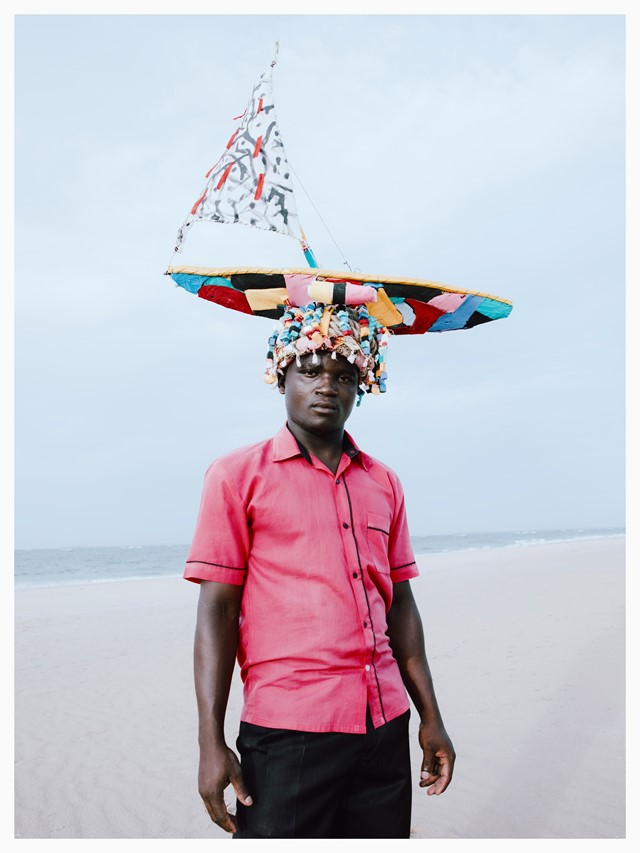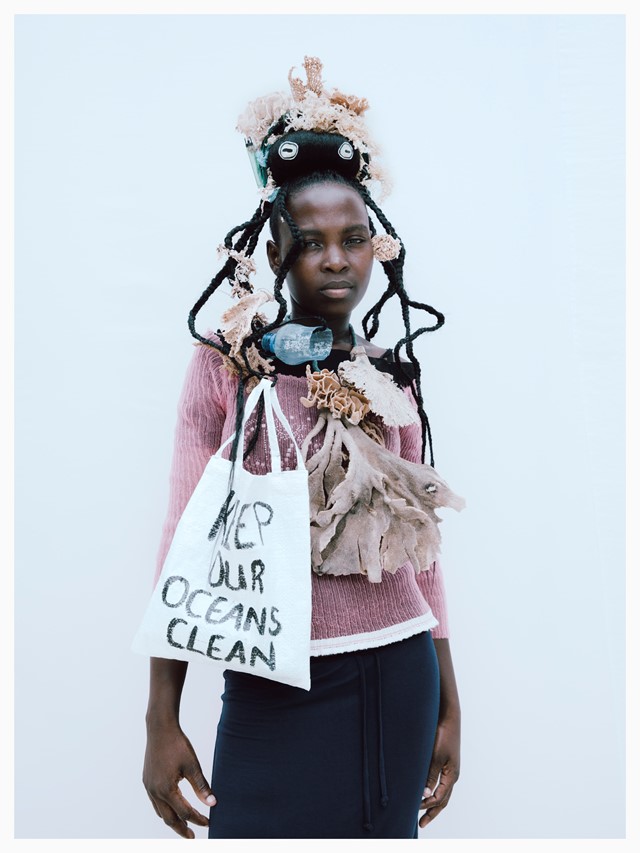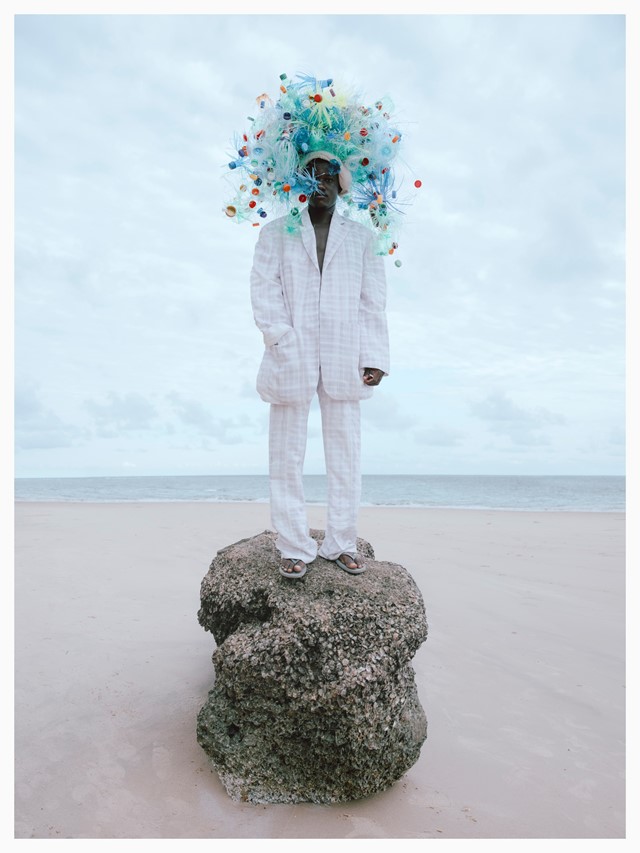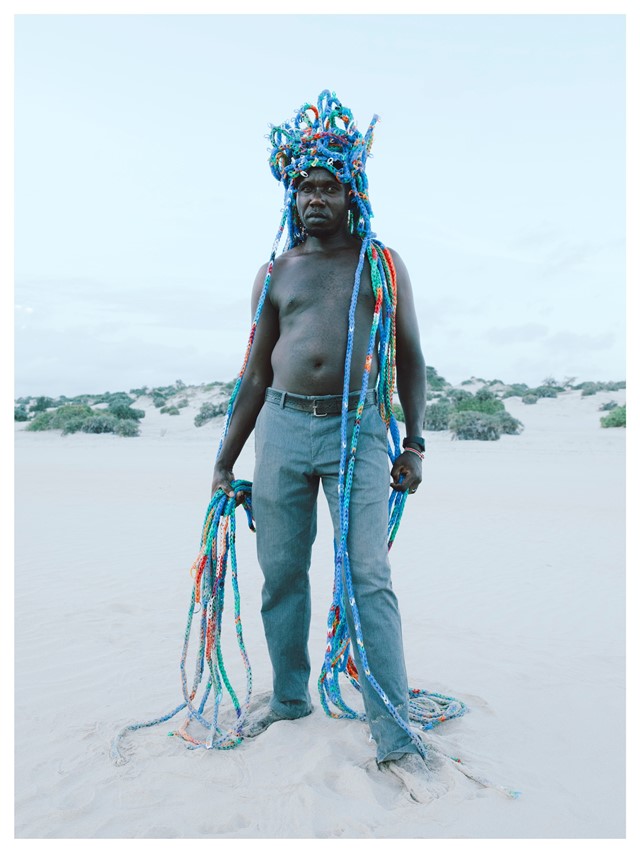Photographer Kristin-Lee Moolman and stylist Louise Ford present a body of work that sheds light on the Shela Hat Contest, an extraordinary hat-making competition on the Kenyan island of Lamu
Every two years, the Lamu community in Kenya comes together for the Shela Hat Contest: an event which started out as a light-hearted affair but has evolved into something altogether more political, allowing the community to address issues affecting them via a surprising medium: hat-making. The contest invites members of the community to create a hat using objects found in the local area, which comments on the growing ecological threats they as a community are facing.
‘‘I grew up in Zimbabwe and spent a lot of my childhood in Kenya,’’ says Louise Ford, a stylist who is working to champion the participants of the Shela Hat Contest, which took place in February of this year. ‘‘Founder and friend of the contest, Herbert Menzer, told me about the unique and unprecedented competition, so I saw an opportunity to marry my experience in image-making as a stylist, and sought to collaborate with a fine art photographer who would immortalise the event in a way that would allow us to create a body of work, benefiting the community as a whole.”
Working closely with photographer Kristen Lee-Moolman, who is from South Africa, the duo have done just that, producing a beautiful series of photographs that capture the participants of this contest and celebrate their intense creativity. Ford and Moolman are now selling these images to raise money for the New Leaf Rehabilitation Centre, which was founded by Showsee Mohammed five years ago and is working to help those affected by drug addiction in Lamu. Here, we speak to the duo about the project as well as their hopes for it.

Vincent Desmond: Can you tell me about the history of the Shela Hat Contest?
Kristen-Lee Moolman: Lamu is a small island off the coast of Kenya. It is a 700-year-old settlement and one of the last preserved examples of ancient Swahili culture. It is also very close to the Somali border. Since the contest’s conception in 2010, every other year the Shela community come together to celebrate creativity and innovation, but also to communicate issues of protest. Each hat usually embodies some sort of environmental or political message about the community’s most pressing needs and worries.
This year the prevailing themes were recycling, respect for natural habitats, a food shortage due to a plague of locusts, the rise of unregulated and accident-prone motorbike taxis and government mobile network discrepancies making connectivity a big challenge for islanders running their businesses. Although activism is a tangible theme of the day, the event remains for most part a light-hearted community initiative and a moment of solidarity, collaboration and of course, competition.
The prize money is a significant amount, so much so that sometimes a group of mates get together to design a ‘collective’ hat and split the winnings. As you can see from the portraits, designs vary from complex structures crafted over a three-month period in the build-up to the competition, to impromptu last-minute headgear fashioned from a found palm frond and discarded flip-flop. It’s also important to note that most of the contestants are not artists or artistically trained. The skills and creative talent are often self-taught.
VD: How did you go about capturing these images?
Louise Ford: My role in this project was in producing and art directing. With the help of local friends who speak Swahili, we took the contact details of about 50 contestants whose hats stood out to us either in their complexity or their simplicity. We then arranged to meet the participants to take their portraits in the days that followed. In return, we paid them for their time and talked them through our intentions of raising money for the New Leaf Centre. They nearly all knew about New Leaf and shared a sense of enthusiasm and solidarity in helping the clinic.
KLM: From an aesthetic standpoint I wanted the focus to be on the artists and their pieces, elevating them almost as sculptures, separated from the surroundings and emphasised by minimal but visually structured natural or white backdrops.
VD: Do you have a favourite?
KLM & LF: Maxwell Kiptoon. He is an artist and craftsman who works at a Lamu beachfront shop. His hat was made from several thousand bottle caps found littered on the beaches and shorelines of the island. Themes dealing with recycling, pollution and keeping the ocean clean were prevalent throughout the entire competition.

VD: Print sales are having a real moment right now, why do you think it’s become such an effective way to raise money for important causes?
KLM & LF: We’re trying to keep this separate from the many great print sales happening right now, only because our price points and formats are different to some of the current print sales. The works are 84 x 54cm and printed on archival media. We wanted to keep the works as limited numbered editions to respect the buyers as well and pay homage to the artists who created the hats.
VD: Why is this project significant to you as individuals?
KLM: The project is significant to me because as someone who grew up in an African country, you are constantly presented with negative images and news portraying poverty and violence. The wealth of culture, the beauty of the landscapes, and the creative vision of many who live here is overshadowed by these stereotypes. The goal is always to contradict these stereotypes by capturing the positives that are often ignored. This particular project is about optimism, empowerment and pay homage to the creative vision of the artists of Lamu.
VD: What are the guiding principles in curating this year’s competition?
LF: The hats were evaluated by a board of judges including the founder, local artist residency teachers and community leaders of the island. Decisions are made based on skill, craftsmanship, originality and story.

VD: What can you tell us about the work of the New Leaf Centre?
KLM & LF: It’s a rehabilitation clinic which helps by giving clients medication to suppress withdrawal symptoms. They also take part in group counselling. The organisation has a 60 per cent success rate so far, which is very positive. The crisis affects many people, mostly men aged between 15 and 65. The force of this project lies in the fact that if children have a father clean from drugs, entire families benefit from the programme; women, children, the local orphanage benefit indirectly too.
VD: How have the communities reacted to the New Leaf Centre since it was opened?
KLM: The clinic opened in March 2018 so it is relatively new. The current issue is that since patients are typically not able to pay for their own care, the clinic relies on charitable donations which are few and far between, and more so during this pandemic. The awareness and the rehabilitation provided by the New Leaf rehabilitation clinic is more important now than ever.
VD: What do you hope to achieve with this project?
KLM & LF: Aside from showcasing the skill and vision of the individual contestants, we hope to shed light on substance dependacy issues in Lamu and the work of the New Leaf Centre, in the hope that we can raise enough to enable the foundation to treat more patients and as a result the families that depend on them. Also, the Shela Hat Contest will possibly not happen next year due to lack of funding. We would like to ensure that the competition does happen next year by contributing to the prize fund.
The exhibition is at 697thz.com, which is created and directed by designstudio 697 THz, from November 23 – December 15, 2020. For print sales please email: 28hatsforlamu@gmail.com.
Photography: Kristin-Lee Moolman. Styling: Louise Ford. Exhibition consultant and text: Lucy Kumara Moore. Production Jemima Carr and James Newman. Special thanks to Herbert Menzer and Simon Jacquemus.
